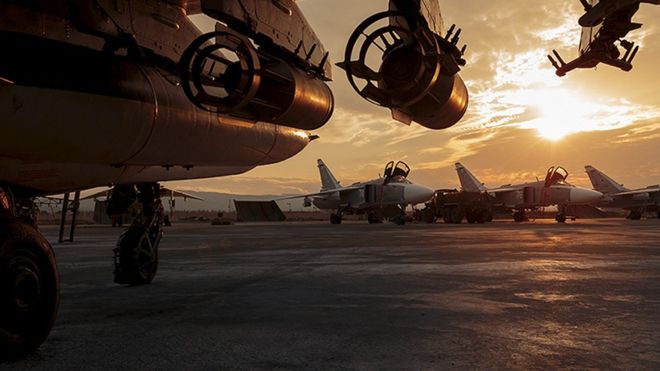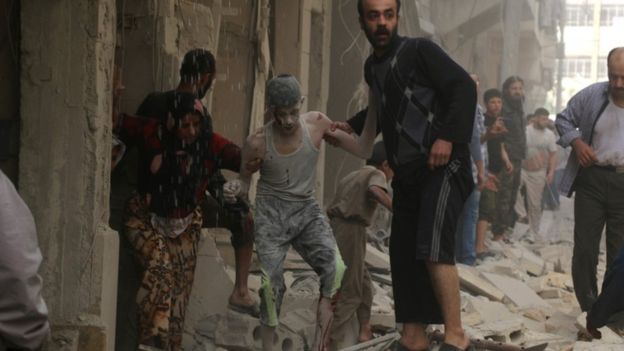The truth behind Russia’s continuing war in Syria

All the signs are that as the partial truce in Syria fails and the peace talks falter, the Russian military and its Syrian allies are gearing up for a new offensive in and around Aleppo.
Last week, the Pentagon said forces loyal to the Syrian government were beginning "to mass and concentrate combat power around Aleppo."
The US spokesman said: "It is primarily [the] al-Nusra [Front] who holds Aleppo, and, of course, al-Nusra is not part of the cessation of hostilities. So it's complicated. We're watching it."
As so often with recent Russian military campaigns, the media message has been at variance with the reality of events on the ground.
In mid-March, President Vladimir Putin announced Russia was to begin withdrawing its forces from Syria.
Some fixed-wing aircraft — up to about half of the deployed jets — did depart from the Russian air base near Latakia.
But their departure did not mark an end to Russian military operations. Far from it.
Russian strike missions continued; now bolstered by the arrival of some of the Russian military's latest attack helicopters — the Ka-52 and the Mi-28N.
So what is going on? What changed if anything after Russia's partial withdrawal? And why are the Russians apparently gearing up for a new offensive?
For the moment, Russia's support for President Assad remains firm. But that is not necessarily an open-ended proposition.
Russia wants to consolidate the Syrian government's position — but it doesn't want to remain engaged in combat in Syria forever.
Thus Russian policy operates on a number of tracks. Moscow has backed the diplomatic process. It may be failing for now, but the diplomatic effort will have to be resumed at some point.
The Russian "withdrawal" signalled a shifting of gears in the campaign; a signal of a job at least part-done — the consolidation of the Syrian government — and a step that helped give space for a renewed diplomatic effort.
The US has repeatedly criticised Russia's air campaign for largely striking at Western-backed groups fighting the Syrian government, rather than so-called Islamic State (IS).
Rhetoric and reality
Russia, of course, has said it is largely striking at IS and al-Nusra "terrorists".
This is another example of the gulf between Russian rhetoric and reality.
But, as Michael Kofman, a US-based analyst with the CNA Corporation, says, about a week before the "withdrawal" announcement, the Russian air effort switched to largely striking IS in and around Palmyra, yielding "a political prize and an important public victory for the Syrian regime and the Russian forces".

This, then, created the context for the partial withdrawal, and IS subsequently became the primary target for Russian air power — a point confirmed by recent US briefings.
Russia's air wing in Syria has undoubtedly been scaled back.
Indeed, analysis of satellite imagery by IHS Janes shows one of the two runways at the Humaymim air base, near Latakia, appears to have been closed.
Janes suggests damage may have been caused by over-use and this "may have contributed to Russia's decision to withdraw some fixed-wing aircraft from Syria and deploy additional helicopters".
Nonetheless, a sizeable Russian force still remains in Syria.
There is an air wing of some 20 aircraft, including about a dozen Su-24M strike aircraft and a handful of Su-30M and Su-35 fighters.
And there are still a variety of ground elements deployed to protect the air base, including highly capable surface-to-air missiles.
Indeed, as Mr Kofman says, the arrival of more attack helicopters means "Russia's military presence has expanded to several bases, since helicopters need forward operating bases to fly from".
US and other sources have detected Russian artillery units moving towards the Aleppo front, and teams of Russian special forces are thought to be operating alongside both Syrian government and allied Hezbollah units.
So, for now, all eyes are on Aleppo.
But if Russia has shifted gears in its approach, so too have the Americans.
President Barack Obama's decision to double down on IS — not least by deploying up to 250 additional special operators in Syria to train and assist a coalition of Kurdish and Arab fighters — indicates that key outside players are already gearing up for an upsurge in the fighting.
Syria's multiple wars show no sign of ending.
What did Russia achieve in Syria?
- Russian aircraft flew more than 9,000 sorties
- destroyed 209 oil production and transfer facilities
- helped Syrian government troops retake 400 settlements
- helped Damascus regain control over more than 10,000 sq km (3,860 sq miles) of territory
Политика конфиденциальности | Правила пользования сайтом










